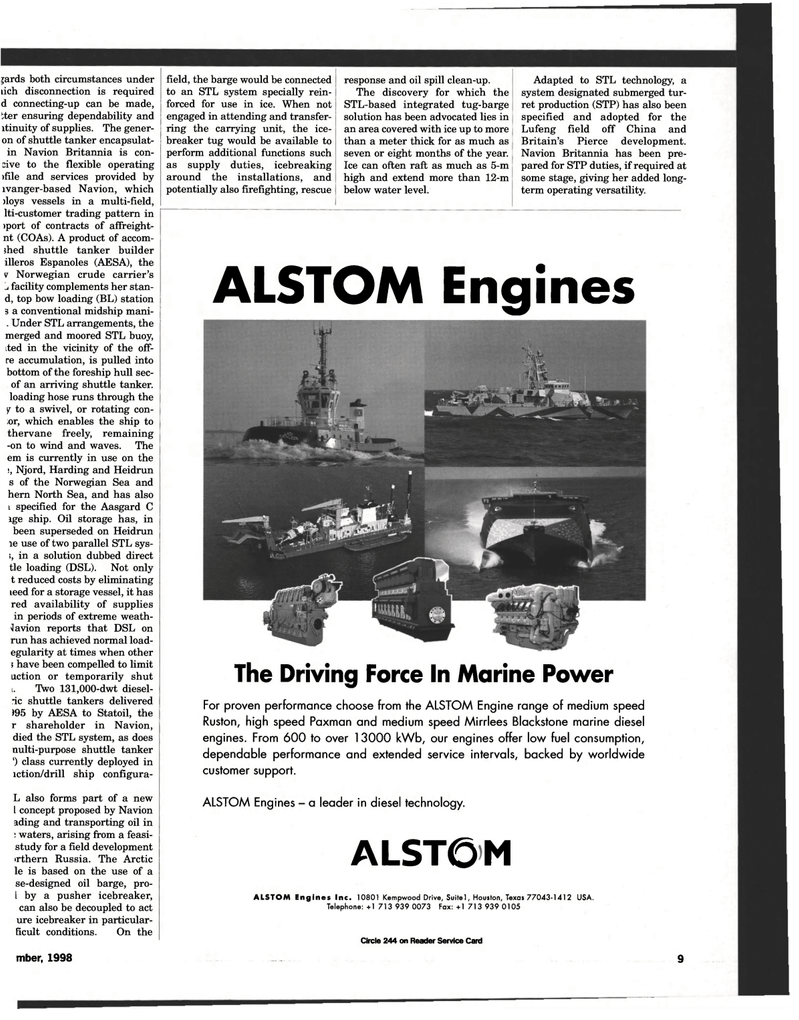
Page 9: of Maritime Reporter Magazine (September 1998)
Read this page in Pdf, Flash or Html5 edition of September 1998 Maritime Reporter Magazine
jards both circumstances under lich disconnection is required d connecting-up can be made, tter ensuring dependability and itinuity of supplies. The gener- on of shuttle tanker encapsulat- in Navion Britannia is con- eive to the flexible operating >file and services provided by ivanger-based Navion, which )loys vessels in a multi-field, lti-customer trading pattern in >port of contracts of affreight- nt (COAs). A product of accom- shed shuttle tanker builder illeros Espanoles (AESA), the v Norwegian crude carrier's j facility complements her stan- d, top bow loading (BL) station 3 a conventional midship mani- . Under STL arrangements, the merged and moored STL buoy, ited in the vicinity of the off- re accumulation, is pulled into bottom of the foreship hull sec- of an arriving shuttle tanker, loading hose runs through the y to a swivel, or rotating con- ;or, which enables the ship to thervane freely, remaining -on to wind and waves. The em is currently in use on the ), Njord, Harding and Heidrun s of the Norwegian Sea and hern North Sea, and has also t specified for the Aasgard C ige ship. Oil storage has, in been superseded on Heidrun le use of two parallel STL sys- s, in a solution dubbed direct tie loading (DSL). Not only t reduced costs by eliminating leed for a storage vessel, it has red availability of supplies in periods of extreme weath-
Javion reports that DSL on run has achieved normal load- egularity at times when other 5 have been compelled to limit action or temporarily shut i. Two 131,000-dwt diesel- *ic shuttle tankers delivered >95 by AESA to Statoil, the r shareholder in Navion, died the STL system, as does nulti-purpose shuttle tanker ') class currently deployed in iction/drill ship configura-
L also forms part of a new
I concept proposed by Navion ading and transporting oil in : waters, arising from a feasi- study for a field development irthern Russia. The Arctic le is based on the use of a se-designed oil barge, pro- l by a pusher icebreaker, can also be decoupled to act ure icebreaker in particular- ficult conditions. On the field, the barge would be connected to an STL system specially rein- forced for use in ice. When not engaged in attending and transfer- ring the carrying unit, the ice- breaker tug would be available to perform additional functions such as supply duties, icebreaking around the installations, and potentially also firefighting, rescue response and oil spill clean-up.
The discovery for which the
STL-based integrated tug-barge solution has been advocated lies in an area covered with ice up to more than a meter thick for as much as seven or eight months of the year.
Ice can often raft as much as 5-m high and extend more than 12-m below water level.
Adapted to STL technology, a system designated submerged tur- ret production (STP) has also been specified and adopted for the
Lufeng field off China and
Britain's Pierce development.
Navion Britannia has been pre- pared for STP duties, if required at some stage, giving her added long- term operating versatility.
ALSTOM Engines
The Driving Force In Marine Power
For proven performance choose from the ALSTOM Engine range of medium speed
Ruston, high speed Paxman and medium speed Mirrlees Blackstone marine diesel engines. From 600 to over 13000 kWb, our engines offer low fuel consumption, dependable performance and extended service intervals, backed by worldwide customer support.
ALSTOM Engines - a leader in diesel technology.
ALSTOM
ALSTOM Engines Inc. 10801 Kempwood Drive, Suitel, Houston, Texas 77043-141 2 USA.
Telephone: +1 713 939 0073 Fax: +1 713 939 0105
Circle 244 on Reader Service Card 9 mber, 1998

 8
8

 10
10
